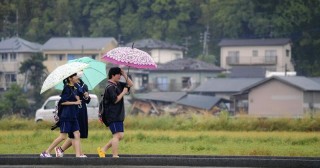Loading
Search
▼ Bus Services Start for Students in Kumamoto
- Category:Other
KUMAMOTO (Jiji Press) — Alternative bus services mainly for high school students started in the Aso region in Kumamoto Prefecture on Monday as roads and railways have been heavily damaged by massive landslides caused by a series of strong earthquakes in the prefecture.
With the bus services, the number of students unable to go to schools that have resumed classes is expected to decrease sharply.
According to sources including the prefecture’s board of education, about 500 students at 29 public and private high schools commute between the Aso region and areas including the city of Kumamoto, the capital of the prefecture.
The disruption of the public transport systems had prevented many of them from attending classes. The village of Minami-Aso and the town of Takamori jointly started the alternative bus services, to four areas including the capital city and the city of Aso, to send students to and back from their high schools.
It takes about two hours for a Kumamoto-bound bus to get to the city, however, because it has to use a diversion route.
Kyushu Railway Co., better known as JR Kyushu, began to operate buses as an alternative transport means for the section between Higo-Ozu and Miyaji stations on its Hohi Line, which connects Kumamoto Prefecture and neighboring Oita Prefecture. The section has been suspended due to damage from the quakes.
“I’m happy I can go to my school after a long absence,” said Hakana Goto, 16, a second grader at a private high school in the city of Kumamoto.
Ayaka Goto, a 19-year-old student at a university in Kumamoto, said: “The alternative service is a blessing although the buses depart early in the morning. I wonder if I can sleep in the bus.”
Also on Monday, 67 primary and middle schools in the cities of Kumamoto and Aso, five towns including Mashiki, and the village of Minami-Aso were set to resume classes.
In Mashiki, where two quakes — one on April 14 and the other two days later — measured the maximum level on the Japanese seismic intensity scale of 7, Kiyama Middle School resumed classes at a nearby primary school in the morning because part of its buildings is in a hazardous location.
Six other schools in the town were to reopen later on Monday.
“I’m very much looking forward to seeing my friends,” Saki Arakawa, a 14-year-old third grader at Kiyama Middle School, said with a big smile.
Ibuki Mashima, 12, who entered the school this spring, said, “I want to talk with my friends about the earthquakes and our houses.”
Yoshihisa Nagase, 53, the school’s principal, said: “Some students tend to not show smiles at shelters in consideration of other evacuees. But I can see their genuine smiles here as they are with friends.” He added, “I believe that our students can overcome difficulties with the power of smile.”
Mashiki’s board of education operates buses for the transportation of students staying at evacuation centers far from their schools. Schools in the town plan to provide psychological support to students in cooperation with school counselors.
- May 11, 2016
- Comment (0)
- Trackback(0)


